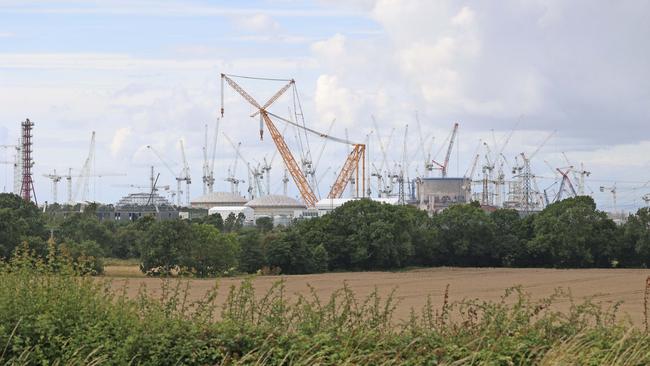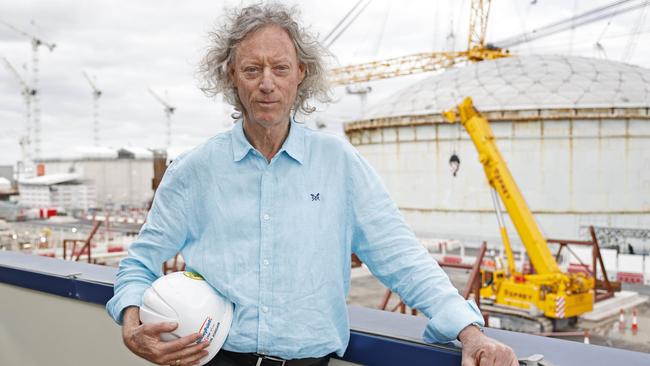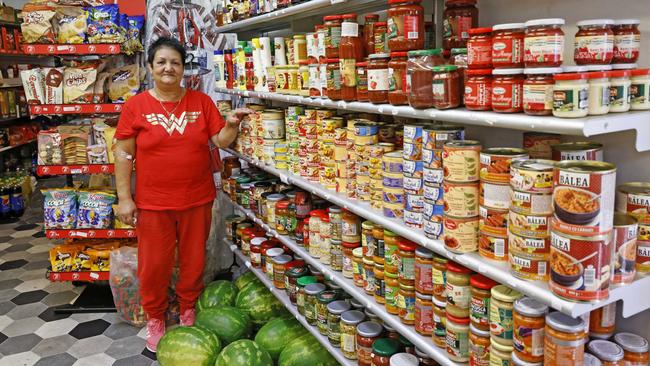How UK’s Hinkley Point C nuclear station will power six million homes
Nuclear is integral to future energy needs, according Australian Rob Jordan, who is overseeing a major UK project that has benefits beyond net zero carbon emission targets. See why.
Environment
Don't miss out on the headlines from Environment. Followed categories will be added to My News.
Security engineer David Grier shares a jovial moment with the local butcher on his break from Britain’s flagship nuclear power plant Hinkley Point C, situated on the low-lying muddy shoreline of England’s South West.
“Malcolm, if it wasn’t for Hinkley, I’d be sitting at home on the couch eating pies all day,” he muses to master butcher Malcolm Pyne in the closest town in rural Somerset.
Malcolm’s family-run business is enjoying additional annual turnover of $1.9 million by supplying 30,000 sausages a week to plant workers, as part of a bespoke system of 350 local companies in a continuous supply chain to the project.

Hinkley Point C, on the edge of Somerset – home to world famous Glastonbury festival – is in the final peak construction phase.
When the towering cranes and yellow diggers occupying 174ha of muddy fields are gone, Hinkley Point C (HPC), with its two 1.6GWe EPR reactors, will emerge the most expensive power station in the world, providing six million homes with low carbon energy, boosting energy sovereignty and reducing reliance on fossil fuels in its 60-year operational life.
Currently 40 per cent of the UK’s power is from gas, of which half is imported, 10 per cent is electricity imported through giant cables from other countries, 25 per cent is wind, 15 per cent nuclear and 5 per cent solar.
The remainder is a mix of coal, hydro and renewable biomass.


“HPC is important for energy security as well as meeting our net zero carbon emissions targets,” said project construction delivery director Rob Jordan, originally from Toowoomba in Queensland.
“Nuclear energy is integral to the future if England is to produce its own energy requirements, keep down costs and boost energy security so that when Russia invades Ukraine and drives up wholesale prices and volatility, we’re not held to ransom,” he said.
“It’s safe, clean and reliable and is a response to climate change.
“And it makes sense for Australia to go nuclear. If I didn’t believe in it I wouldn’t be here.”

Hinkley Point C was the dream of former prime minister Tony Blair, who in 2005 promised a new generation of nuclear power plants to reduce carbon emissions and advance Britain towards sovereign power production.
The megaproject has around 10,000 workers on site a day and has spawned 25,000 jobs across the UK.
It will also see 30,000 apprentices trained.
The sprawling mass of steel cranes, scaffolding and concrete buildings is home to a self-contained community with units for workers, an ambulance service, police station, medics, shops and a 150-strong fleet of buses ferrying workers to and from the site.

While it has been mired in financial, political and technical difficulties – seven years after the first concrete was poured, it is not operational and remains the biggest building site in Europe – the government and Somerset communities say Hinkley Point C is worth the fight.
To pay for it, the British government entered into a complex financial agreement with state-owned French energy giant EDF and China General Nuclear Power Group (CGN), a state-run Chinese energy company.
The British government is also building a replica sister nuclear plant Sizewell C in Suffolk.
Click here to find all the stories in Future Energy campaign
The Somerset Chamber of Commerce has set up a bespoke recruitment portal for the newly-skilled workforce for when new nuclear projects, like Sizewell C, and a planned Jaguar Land Rover’s new electric vehicle battery plant, are built.
And there are many indirect beneficiaries too.
Hairdresser Ozzy, who runs Turkish barber shop Ozzy’s, has been in business for 21 years but says since Hinkley opened, 50 per cent of his business comes from the workers.
It’s the same for Asens Tikalcheve, 30, who opened his barber shop in nearby Bridgewater in 2017.

“I got lucky, opened my shop in 2017 and was one of just two barbers with no competition. It was quiet but now everyone knows me, the workers at the plant are keeping me in business,” he said.
Dairy farmer John Cottrell, 78, delivers 7000 litres of milk a week to the plant and helped set up the bespoke supply chain to it.
“Hinckley has been a lifeline to us, it’s a constant source of demand,” he said.
Shopkeeper Aurelia Maltutan, who runs Magazin General Alimentar, a grocery store selling Romanian products in Bridgewater, said: “Hinckley has been great for me. We opened four years ago and a lot of the workers at the plant are from Romania and like to buy from us.
“The English didn’t really know much about Romanian food before but now we’re getting demands for special foods from the workers.”

In July, MPs on the cross-party science, innovation and technology committee backed new nuclear generation but said ministers had failed to set out a path to increase nuclear capacity to 24 gigawatts by 2050 – up from about six gigawatts today.
Yet UK Energy Security Secretary Grant Shapps underlined the government’s commitment to mega projects Hinkley Point C and Sizewell C in launching Great British Nuclear, a body to lead efforts to find sites that can house future nuclear power stations, including small modular reactors.
“I’m proud to be turbocharging the revival of new nuclear,” he said.
“By rapidly boosting our homegrown supply of nuclear and other clean, reliable, and abundant energy, we will drive down bills for British homes and make sure the UK is never held to energy ransom by tyrants like (Russian President Vladimir) Putin.”
Lincoln Hill, Nuclear Industry Association director of policy and external affairs, said: “Hinkley Point C will deliver a huge amount of clean, reliable sovereign power.
“It will make Britain more autonomous by producing its own electricity consumption, but it won’t make us fully autonomous because we use so much energy.
“Hinkley Point C is getting us out of a hole we’ve been digging ourselves into.
“The answer is not to abandon (projects like this), but commit big and bold and replicate for mass efficiency.
“If we don’t do it, in six years’ time we will have to find five billion cubic metres of extra gas from global markets – 6 million homes’ worth of extra power – when there are no other sources.
“Sovereign energy is not dependent on the weather, or on what the Russians are doing in the gas markets – it depends on scientists and engineers building power stations.”
Land surveyor Ellie Labbett, 20, who joined the EDF five-year apprenticeship scheme, is among the 12 per cent of women at the plant and works inside one of the two giant reactor buildings.
“It’s deep beneath the sea level but not scary, it’s exciting,” she said. “I’ve been here two years and I’m hoping to see out the duration of the project and the progression of the reactors.
“It’s a dream job being an engineer and I’m hoping to stay on when it’s operational.”
The total bill to date for the project is £33 billion ($63.7 billion), up from previous estimates of £26bn ($50 billion) and originally £18bn ($35 billion) when officially approved in 2016.
It is also two years behind schedule.
And some experts believe that the unit 1 nuclear reactor, scheduled to be operational in June 2027 – with unit 2 commissioning in 2028 – will actually prove impossible to build.
“Nuclear is horribly expensive and HPC has been subject to massive delays – it’s too little, too late,” said Paul Dorfman from the UCL Energy Institute.
“It takes up to 20 years to build one power station. You have to act very, very fast and keep building them simultaneously as they have a limited life span, or you’re stuffed,” he said.
“You’ll be lucky if it’ll open before 2030.”
To pay for it, the British government entered into a complex financial agreement with state-owned French energy giant EDF and China General Nuclear Power Group (CGN), a state-run Chinese energy company.
“It’s a bad deal for the consumer. The government bought all its electricity for 35 years in advance at a fixed price in 2016 of £92 a 50 megawatt hour,” said Roy Pumfrey, of the Stop Hinkley protest group.
“And it’s (inflation) index-linked so prices are still rising. The Ukraine war has seen electricity prices decline, you can buy offshore wind and electricity in Britain under £40 a megawatt hour – half the cost of the 2016 price. Renewables are much cheaper.”
Radioactive waste from the plant is to be disposed of at a Sellafield nuclear site in Cumbria, North East England.
Originally published as How UK’s Hinkley Point C nuclear station will power six million homes



